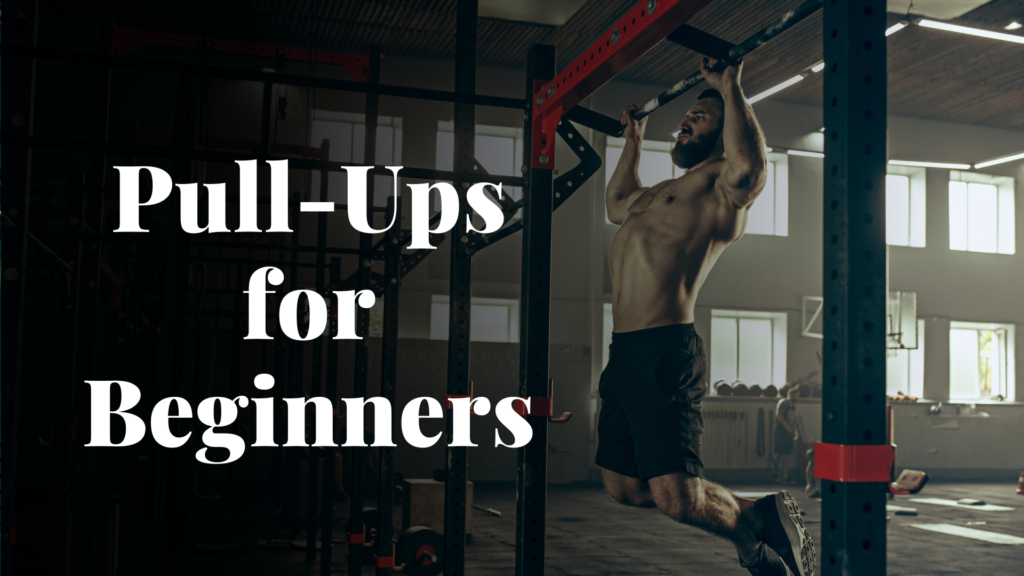Everything You Need to Know About Pull-Ups for Beginners
5 min read
Introduction: The Ultimate Guide to Mastering Pull-Ups for Beginners
Are you a beginner looking to take your fitness journey to new heights? Are you eager to build upper body strength, increase muscle mass, and challenge yourself with an exercise that targets multiple muscle groups? Look no further than pull-ups! Pull-ups are a fantastic compound exercise that engages your back, shoulders, arms, and core. In this comprehensive guide, “Everything You Need to Know About Pull-Ups for Beginners,” we will walk you through the fundamentals of pull-ups, provide step-by-step instructions, and offer valuable tips to help you master this challenging exercise. So, let’s dive in and discover the secrets to conquering pull-ups like a pro!
Pull-Ups: A Total Body Workout
Pull-ups, often hailed as the king of upper body exercises, offer a multitude of benefits for beginners and advanced fitness enthusiasts alike. Let’s explore why pull-ups are such an effective total body workout.
Engaging Multiple Muscle Groups Simultaneously
Pull-ups primarily target the latissimus dorsi muscles (lats), which are the large muscles in your back responsible for giving you that desirable V-shape. However, they also engage several other muscle groups, including:
- Biceps: The muscles on the front of your upper arms.
- Rhomboids: Located between your shoulder blades, these muscles help stabilize your shoulder girdle.
- Trapezius: Located in your upper back and neck, the traps assist in shoulder and neck movement.
- Deltoids: The muscles forming the rounded contours of your shoulders.
- Forearms: The muscles in your lower arms that help with gripping.
By targeting multiple muscle groups simultaneously, Gym Wrist Wraps provide a well-rounded workout, helping you build strength,increase muscle definition, and improve overall fitness.
Core Strengthening and Stability
While pull-ups mainly focus on the upper body, they also engage your core muscles, including the rectus abdominis, obliques, and transverse abdominis. These muscles stabilize your torso during the exercise, promoting a strong and stable core. Building core strength through pull-ups can have a positive impact on your overall functional fitness and posture.
Improved Grip Strength
One often overlooked benefit of pull-ups is the improvement in grip strength. Since pull-ups require you to hang and support your body weight, your forearms and hand muscles work hard to maintain a secure grip on the bar. As you progress with pull-ups, you’ll notice a significant improvement in your grip strength, which can have carryover benefits to other exercises and activities in your daily life.
Getting Started: Step-by-Step Guide to Performing Pull-Ups
Now that we understand the fantastic benefits of pull-ups let’s delve into the step-by-step process of performing a pull-up correctly. Following these instructions will ensure proper form and help you avoid injuries.
Step 1: Find a Suitable Pull-Up Bar
The first step is to locate a sturdy and secure pull-up bar. You have several options:
- Gym pull-up bar: If you have access to a gym, they typically provide pull-up bars in the weightlifting area or on dedicated pull-up stations.
- Doorway pull-up bar: These bars attach to the door frame and offer convenience for home workouts.
- Outdoor pull-up bar: Parks or playgrounds often have pull-up bars that you can utilize for outdoor workouts.
Choose a bar that is at least a foot higher than your reach to allow ample space for your body during the exercise.
Read Also – Benefits of Aloe Vera and Hair Care Tips for Men
Step 2: Warm Up Properly
Before engaging in any physical activity, it’s crucial to warm up your muscles to prevent injuries. Perform dynamic stretches and light cardio exercises such as jogging or jumping jacks to increase your heart rate and loosen up your muscles. This will prepare your body for the intense workout ahead.
Step 3: Correct Grip and Hand Placement
To perform a pull-up, you need to have the correct grip and hand placement on the bar. Follow these steps:
- Stand beneath the bar and reach up, gripping it with your palms facing away from you.
- Position your hands slightly wider than shoulder-width apart for a standard grip.
- Alternatively, you can use a close grip with your hands positioned closer together or a wide grip with your hands positioned wider than shoulder-width apart to target different muscle groups.
Step 4: Hanging Position
Once you have the correct grip, hang from the bar with your arms fully extended. Keep your shoulders relaxed, engage your core, and maintain a neutral spine position. This is the starting position for your pull-up.
Step 5: Initiating the Pull-Up
Now it’s time to start the pull-up movement. Follow these steps:
- Begin by pulling your shoulder blades down and back, engaging your back muscles.
- Bend your elbows and pull your body upward until your chin clears the bar. Focus on using your back muscles to initiate the movement rather than relying solely on your arms.
Step 6: The Descent
Once you have completed the upward phase of the pull-up, slowly lower your body back down to the hanging position. Control the descent to maximize muscle engagement and prevent swinging or dropping too quickly.
Step 7: Repeat and Progress
Congratulations! You’ve completed your first pull-up. Aim to perform a set of 8-12 reps, gradually increasing the number of sets as you progress. As you become more comfortable with pull-ups, you can challenge yourself by adding variations such as weighted pull-ups or switching to more advanced grips.
FAQs: Answers to Common Questions About Pull-Ups for Beginners
- Q: Are pull-ups suitable for beginners who have little upper body strength? A: Absolutely! Pull-ups can be modified to suit your fitness level. If you’re just starting, you can use resistance bands for assistance or try negative pull-ups, focusing on the lowering phase to build strength gradually.
- Q: How often should we do pull-ups as beginners? A: It’s recommended to start with 2-3 sessions per week, allowing for adequate rest and recovery between workouts. As your strength improves, you can increase the frequency.
- Q: Can I do pull-ups if I don’t have access to a pull-up bar? A: Yes! If you don’t have a bar, you can use alternatives like suspension trainers or gymnastic rings that can be anchored to a sturdy structure.
- Q: What if I can’t do a single pull-up? A: Don’t worry! Start with exercises that target the muscles involved in pull-ups, such as lat pulldowns, assisted pull-ups, or inverted rows. Gradually progress towards full pull-ups as you gain strength.
- Q: Can women do pull-ups? A: Absolutely! Pull-ups are not gender-specific. Women can develop the necessary strength and technique to perform pull-ups just like men.







